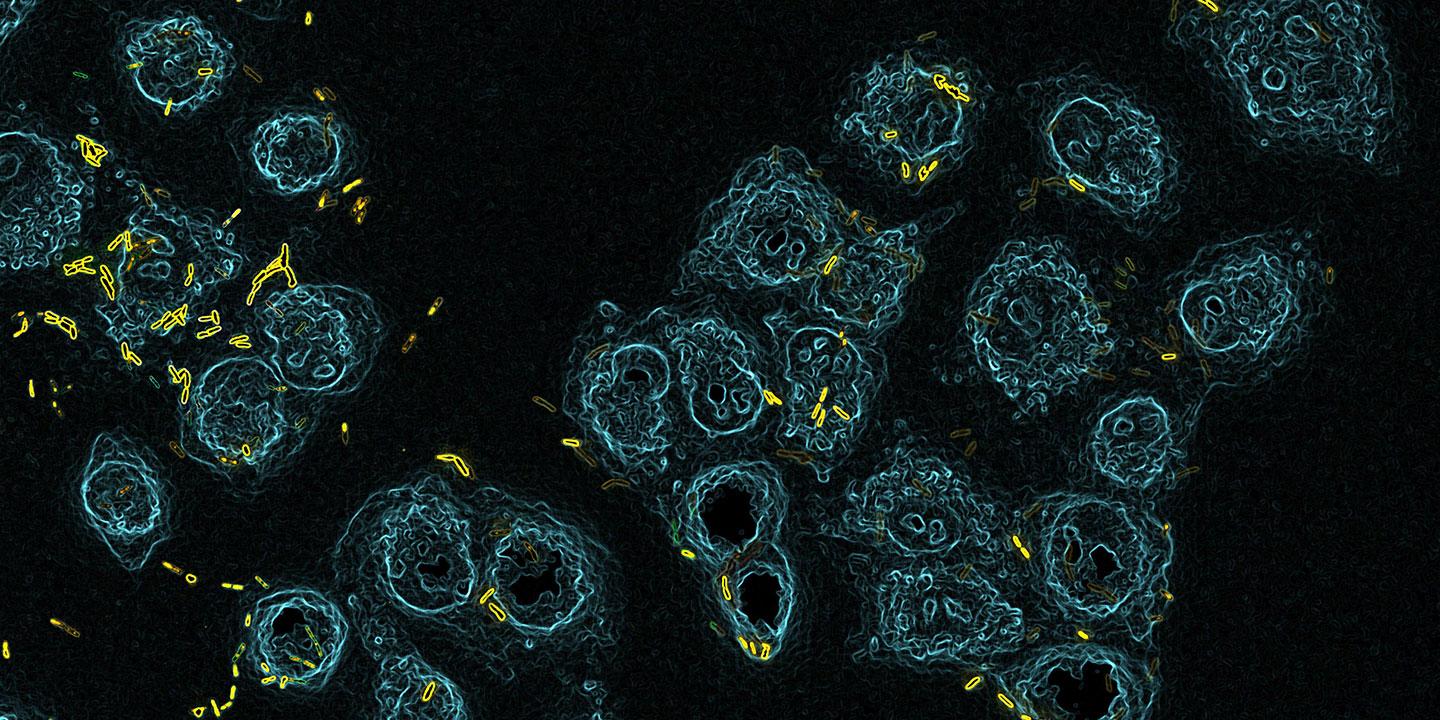Animal experiments and 3R (2/4): mucous membrane as a model

In an SNSF-funded project, researchers are studying how bacteria infect the lungs. They are developing an alternative to animal testing that complements existing methods.
When bacteria enter our lungs or live in our guts, they physically interact with our own cells that line the openings of our body like a protective layer. Some bacteria help us digest, others make us sick. Alexandre Persat from EPF Lausanne is studying how bacteria know their physical surroundings – one could say their sense of touch. Knowing how these microbes navigate through our body may help us to understand and tackle infectious diseases and antibiotic resistance.
A bronchus from aspic and cells
The problem Persat faces is that his microscopes cannot simply enter a human lung or a mouse in-testine to observe bacteria bumping about our cells. This is why he and colleagues have developed systems to grow mouse or human stem cells outside the body. He uses a kind of aspic, a small block of less than a centimetre with a hole in it. The cells grow on this to form a thin tube with layers of cells like the ones in the linings of the gut or a bronchial tuber. By connecting this tube to a system that can pump a liquid or air through the hole, Persat is able to model what happens when bacteria come into contact with human or mouse cells. He is observing live under the microscope the rhythmic movement of the hair-like cilia lining the windpipe and the production of large amounts of mucus by the lung cells.
As no microscope is implanted into a mouse and no drugs are administered, this could be considered a replacement of animal experimentation. But that isn’t Persat’s prime motivation. His aim is to come as close as possible to the situation found in humans: “We can replicate human tissue instead of mak-ing a detour via mouse or simple cell cultures.” He uses human cells taken from donors after opera-tions or after death. “If we take Sars-Cov-2: it infects humans but not mice, so we either need to rely on human data, use human tissue or we have to genetically ’humanise‘ mice, which takes a long time and still does not mirror human physiology entirely.”
Various methods to generate knowledge
But Alexandre Persat still needs some animals for his experiments. The cells he uses grow in a spe-cial liquid, the blood serum of cows collected as a by-product of meat production. It was also neces-sary to euthanise a sole mouse to gain stem cells. Using these cells, Persat’s team create small spheres of tissue, so called organoids, which can mimic real intestines – again accessible to the mi-croscope. For another experiment, he needed biological material from a rat’s tail, which is available on the market.
Despite his work on alternatives, Persat is not opposed to animal experimentation: “Of course I am in favour of it. All of us researchers, we depend on each other for our insights. We cannot reproduce all the phenomena, especially not the complexity of a whole organism.” And he adds: “When the mouse model is not suitable, it is crucial that we find more complex ones that more closely resemble humans. For example some experiments on the hereditary lung disease cystic fibrosis have to be done on pigs.” Nevertheless, he remains convinced that more can be done to replace animal experiments. “We scientists are all aware of the ethical imperatives, but in practice we could do better by sharing our new technologies much more frequently.”
The SNSF uses a strict definition of 3R
The 3Rs (replace, reduce, refine) are ethical principles that guide all research involving animals. The Swiss 3R Competence Centre and the National Research Project “Advancing 3R” fund research that improves research methods related to the principles.
For all other projects, the SNSF applies stringent criteria to determine whether a project counts as a 3R-project. It is not sufficient to apply animal-free methods, there has to be an active push towards fewer and better animal experiments. As a result, roughly 1% of funding applications in biology and medicine are considered to be projects that actively promote 3R methods.
Alexandre Persat has fulfilled the SNSF requirements with two of his projects:
- Project 1: Build spheres to mimic the intestine, 700,000 Swiss francs from 2018 to 2022. Part of normal project funding.
- Project 2: Create airway tissue tube on aspic, 280,000 Swiss francs from 2020 to 2023. Part of the National Centre of Competence in Research (NCCR) AntiResist.
